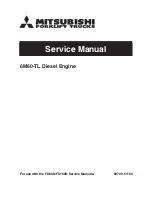
RDG603A73 - Issue 3
Page 89 of 96
Remove contaminated clothing and wash affected skin with soap and water. If persistent irritation occurs,
obtain medical attention. When using high pressure equipment, injection of product under the skin can occur.
If high pressure injuries occur, the casualty should be sent immediately to a hospital. Do not wait for
symptoms to develop.
Eye
Flush eye with copious quantities of water. If persistent irritation occurs, obtain medical attention.
Ingestion
Wash out mouth with water and obtain medical attention. Do not induce vomiting.
Advice to Doctor
Treat symptomatically. Aspiration into the lungs may result in chemical pneumonitis. Dermatitis may result
from prolonged or repeated exposure. High pressure injection injuries require prompt surgical intervention
and possibly steroid therapy, to minimise tissue damage and loss of function.
Because entry wounds are small and do not reflect the seriousness of the underlying damage, surgical
exploration to determine the extent of involvement may be necessary. Local anaesthetics or hot soaks should
be avoided because they can contribute to swelling, vasospasm and ischaemia. Prompt surgical
decompression, debridement and evacuation of foreign material should be performed under general
anaesthetics, and wide exploration is essential.
There may be a risk to health where low viscosity products are aspirated into the lungs following vomiting,
although this is uncommon in adults. Such aspiration would cause intense local irritation and chemical
pneumonitis. Children, and those in whom consciousness is impaired, will be more at risk. Emesis of
lubricants is not usually necessary, unless a large amount has been ingested, or some other compound has
been dissolved in the product. If this is indicated, for example, when there is rapid onset of central nervous
system depression from large ingested volume - gastric lavage under controlled hospital conditions, with full
protection of the airway is required. Supportive care may include oxygen, arterial blood gas monitoring,
respiratory support, and, if aspiration has occurred, treatment with corticosteriods and antibiotics. Seizures
should be controlled with Diazepam, or appropriate equivalent drug.
5. FIRE FIGHTING MEASURES
Specific Hazards
Combustion is likely to give rise to a complex mixture of airborne solid and liquid particulates and gases,
including carbon monoxide and unidentified organic and inorganic compounds.
Extinguishing Media
Foam and dry chemical powder. Carbon dioxide, sand or earth may be used for small fires only.
Unsuitable Extinguishing Media
Water in jet. Use of halon extinguishers should be avoided for environmental reasons.
Protective Equipment
Proper protective equipment including breathing apparatus must be worn when approaching a fire in a
confined space.
6. ACCIDENTAL RELEASE MEASURES
Personal Precautions
Avoid contact with skin and eyes. Wear PVC, Neoprene or nitrile rubber gloves. Wear rubber knee length
safety boots and PVC Jacket and Trousers. Wear safety glasses or full face shield if splashes are likely to
occur.
Environmental Precautions
Prevent from spreading or entering into drains, ditches or rivers by using sand, earth, or other appropriate
barriers. Inform local authorities if this cannot be prevented.
Clean-up Methods - Small Spillages
Absorb liquid with sand or earth. Sweep up and remove to a suitable, clearly marked container for disposal in
accordance with local regulations.








































